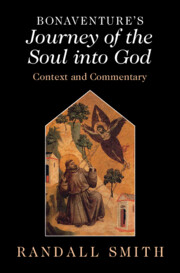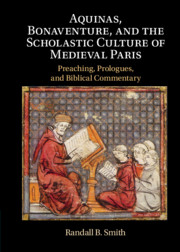146 results

Bonaventure's 'Journey of the Soul into God'
- Context and Commentary
- Coming soon
-
- Expected online publication date:
- September 2024
- Print publication:
- 30 September 2024
-
- Book
- Export citation
Commentary on Thomas Aquinas's Treatise on Divine Law by J. Budziszewski, Cambridge University Press, Cambridge, 2021, pp. xlviii + 475, £75.00, hbk
-
- Journal:
- New Blackfriars / Volume 103 / Issue 1107 / September 2022
- Published online by Cambridge University Press:
- 01 January 2024, pp. 697-700
- Print publication:
- September 2022
-
- Article
- Export citation
5 - Hic Est Liber
- from Part Two - Thomas Aquinas
-
- Book:
- Aquinas, Bonaventure, and the Scholastic Culture of Medieval Paris
- Published online:
- 05 February 2021
- Print publication:
- 04 February 2021, pp 99-127
-
- Chapter
- Export citation
15 - Bonaventure, Sermo Modernus–Style Preaching, and Biblical Commentary
- from Part Three - Bonaventure
-
- Book:
- Aquinas, Bonaventure, and the Scholastic Culture of Medieval Paris
- Published online:
- 05 February 2021
- Print publication:
- 04 February 2021, pp 328-343
-
- Chapter
- Export citation
2 - The Basic Elements of the Thirteenth-Century “Modern Sermon”
- from Part One - Preliminaries
-
- Book:
- Aquinas, Bonaventure, and the Scholastic Culture of Medieval Paris
- Published online:
- 05 February 2021
- Print publication:
- 04 February 2021, pp 45-66
-
- Chapter
- Export citation
Part Two - Thomas Aquinas
-
- Book:
- Aquinas, Bonaventure, and the Scholastic Culture of Medieval Paris
- Published online:
- 05 February 2021
- Print publication:
- 04 February 2021, pp 77-230
-
- Chapter
- Export citation
8 - I Have Seen the Lord
- from Part Two - Thomas Aquinas
-
- Book:
- Aquinas, Bonaventure, and the Scholastic Culture of Medieval Paris
- Published online:
- 05 February 2021
- Print publication:
- 04 February 2021, pp 173-197
-
- Chapter
- Export citation
11 - Bonaventure’s Resumptio
- from Part Three - Bonaventure
-
- Book:
- Aquinas, Bonaventure, and the Scholastic Culture of Medieval Paris
- Published online:
- 05 February 2021
- Print publication:
- 04 February 2021, pp 251-288
-
- Chapter
- Export citation

Aquinas, Bonaventure, and the Scholastic Culture of Medieval Paris
- Preaching, Prologues, and Biblical Commentary
-
- Published online:
- 05 February 2021
- Print publication:
- 04 February 2021
12 - Searching the Depths of the Lombard
- from Part Three - Bonaventure
-
- Book:
- Aquinas, Bonaventure, and the Scholastic Culture of Medieval Paris
- Published online:
- 05 February 2021
- Print publication:
- 04 February 2021, pp 289-305
-
- Chapter
- Export citation
Part Three - Bonaventure
-
- Book:
- Aquinas, Bonaventure, and the Scholastic Culture of Medieval Paris
- Published online:
- 05 February 2021
- Print publication:
- 04 February 2021, pp 231-426
-
- Chapter
- Export citation
3 - Principia and the Sermo Modernus
- from Part One - Preliminaries
-
- Book:
- Aquinas, Bonaventure, and the Scholastic Culture of Medieval Paris
- Published online:
- 05 February 2021
- Print publication:
- 04 February 2021, pp 67-76
-
- Chapter
- Export citation
Acknowledgments
-
- Book:
- Aquinas, Bonaventure, and the Scholastic Culture of Medieval Paris
- Published online:
- 05 February 2021
- Print publication:
- 04 February 2021, pp ix-x
-
- Chapter
- Export citation
4 - Rigans Montes
- from Part Two - Thomas Aquinas
-
- Book:
- Aquinas, Bonaventure, and the Scholastic Culture of Medieval Paris
- Published online:
- 05 February 2021
- Print publication:
- 04 February 2021, pp 79-98
-
- Chapter
- Export citation
Dedication
-
- Book:
- Aquinas, Bonaventure, and the Scholastic Culture of Medieval Paris
- Published online:
- 05 February 2021
- Print publication:
- 04 February 2021, pp v-vi
-
- Chapter
- Export citation
13 - Exalting Our Understanding
- from Part Three - Bonaventure
-
- Book:
- Aquinas, Bonaventure, and the Scholastic Culture of Medieval Paris
- Published online:
- 05 February 2021
- Print publication:
- 04 February 2021, pp 306-318
-
- Chapter
- Export citation
Works Cited
-
- Book:
- Aquinas, Bonaventure, and the Scholastic Culture of Medieval Paris
- Published online:
- 05 February 2021
- Print publication:
- 04 February 2021, pp 435-442
-
- Chapter
- Export citation
9 - Aquinas, Sermo Modernus–Style Preaching, and Biblical Commentary
- from Part Two - Thomas Aquinas
-
- Book:
- Aquinas, Bonaventure, and the Scholastic Culture of Medieval Paris
- Published online:
- 05 February 2021
- Print publication:
- 04 February 2021, pp 198-230
-
- Chapter
- Export citation
10 - Bonaventure’s Inception Principium
- from Part Three - Bonaventure
-
- Book:
- Aquinas, Bonaventure, and the Scholastic Culture of Medieval Paris
- Published online:
- 05 February 2021
- Print publication:
- 04 February 2021, pp 233-250
-
- Chapter
- Export citation
Contents
-
- Book:
- Aquinas, Bonaventure, and the Scholastic Culture of Medieval Paris
- Published online:
- 05 February 2021
- Print publication:
- 04 February 2021, pp vii-viii
-
- Chapter
- Export citation



